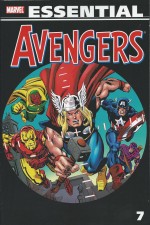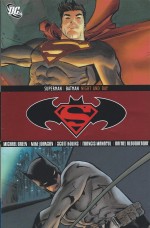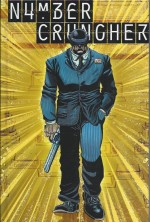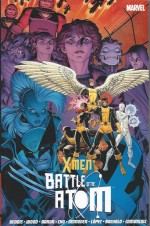
By Gardner Fox, Alfred Bester, Joe Samachson, Jack & Ray Burnley, Mort Meskin, George Roussos, Emil Gershwin & various (DC Comics)
ISBN: 978-1-4012-2283-3
After the staggering success of Superman and Batman, National Comics/DC rapidly launched many other mystery-men in their efforts to capitalise on the phenomenon of superheroes, and from our decades-distant perspective it’s only fair to say that by 1941 the editors had only the vaguest inkling of what they were doing.
Since newest creations Sandman, The Spectre and Hourman were each imbued with equal investments of innovation, creativity and exposure, the editorial powers-that-be were rather disappointed that their later additions never took off to the same explosive degree.
Publishing partner but separate editorial entity All American Comics had by then created many barnstorming successes such as The Flash, Green Lantern, Hawkman and Hop Harrigan and would soon actually produce the only true rival to Superman and Batman’s star status when Wonder Woman debuted late in the year.
Of course AA clearly filtered all ideas through the brilliantly “in-tune†creative and editorial prodigy Sheldon Mayer…
Thus when Starman launched in the April 1941 Adventure Comics (relegating former Sandman to a back-up role in the already venerable heroic anthology), National/DC trusted in craft and quality rather than some indefinable “pizzazzâ€.
Before too long, though, the editors were forced to concede that even the forcefully realistic, conventionally dramatic illustration of Hardin “Jack†Burnley would not propel their newest concept to the same giddy heights of popularity as the Action Ace or Gotham Guardian.
The strip, always magnificently drawn and indisputably one of the most beautifully realised of the period, was further blessed with mature and compelling scripts by Gardner Fox, Alfred Bester, Don Cameron and latterly Joe Samachson but just never really caught on.
However, by today’s standards these compelling, compulsive fun-filled and just plain brilliant tales are some one of the very best comics that era ever produced.
Happily these days, with an appreciably older and more discerning audience, Starman’s less-than-stellar War years career might be more fully appreciated for the superb example of Fights ‘n’ Tights fiction it truly was. This particular volume sees the subtle, moody, slower-paced intellectually edgy stories supplanted by shorter yarns brimming with sheer exuberance and kinetic energy as, with the Nazi menace beaten, home grown criminals began to congregate on comics pages…
Golden Age guru Roy Thomas offers his own absorbing critical overview in the Foreword to this second stunning deluxe hardback collection – completing the Sidereal Sentinel’s tenure in Adventure Comics (issues #77-102, spanning August 1942 to February 1946). The volume even includes some of the most iconic covers of the Golden Age by Joe Simon & Jack Kirby – even though most of them only feature Starman in a little insert in one corner!
As was often the case, although Burnley came up with the concept and look for the Astral Avenger, a professional writer was assigned to flesh out and co-create the stories. At first multi-talented Gardner Fox handled the job, but eventually Alfred Bester began supplying scripts, whilst the illustrator also liberally called on the talents of his brother Dupree “Ray†Burnley as art assistant and inker with their sister Betty as letterer to finish the episodes in sublimely cinematic style.
In those simpler times origins were far less important than today, and the moonlit magic just happened: playboy astronomer and secret genius Ted Knight simply invented a “Gravity Rod†which stored and redirected the incredible power of the stars, and like any decent right-thinking individual created a “mystery man†persona.
Offering Starman’ services to FBI chief Woodley Allen, the Man of Night started his crusade against evil and injustice…
The period peril begins here with ‘Finders Keepers!’ by Fox & Burnley, wherein arch-nemesis The Mist combined his usual invisibility gimmicks with a subtle psychological scheme. When members of the public found valuable “lost property†they had no idea each item carried a post-hypnotic command to surrender their own valuables to the criminal mastermind…
Bester then scripted a thriller dealing with another kind of invisibility for the next issue as Starman and street urchin Mike Muggins ended the impossible robbery-spree of ‘The Little Man Who Wasn’t There!’, whilst in #79 ‘The Tune of Terrific Toby’ (Bester & Burnley again) offered a lighter tone for the tale of a meek office worker who faked a bold rescue to enhance his status only to become embroiled in a concatenation of increasingly dangerous stunts. Happily Starman was able to turn the repentant fool into a real hero…
Burnley bowed out in style in Adventure #80 (November 1942) in Bester’s ‘The Time-Machine Crime!’ wherein thugs used said purloined device to kidnap William Shakespeare, in hopes his canny mind could plan the perfect crime…
Gardner Fox returned for another stint in #81 as the explosively kinetic Mort Meskin & George Roussos briefly took on the art. In ‘Starman’s Lucky Star!’ a poor blind boy who wanted to be an astronomer was mistakenly kidnapped instead of his wealthy playmate. Thankfully the Star Sentinel was available to put everything right, after which ‘Hitch a Wagon to the Stars’ (#82, Fox, Meskin & Roussos) spotlighted a brilliant young inventor whose obsession with astrology blighted his life, and nearly made him a patsy for Nazi spies… at least until Ted Knight and his alter ego intervened.
With Adventure Comics #83 Emil Gershwin became main illustrator for the series – a solid, polished artist much influenced by Mac Raboy – and ‘Wish Upon a Star!’ gave him the opportunity to shine in the moving, socially-charged tale of three prep school boys whose unselfish wishes came true thanks to Starman…
At this time the Astral Avenger’s page counts began to decline as his popularity dwindled – from an average of 11 to 7 or 8 – and ‘The Doom From the Skies’ reflected a growing trend towards fast-paced action as a burglar stole the Gravity Rod, leaving our hero an amnesiac and his weapon a deadly death ray, whilst ‘The Constellations of Crime!’ in #85 introduced Astra the Astrologist who used predictions as the basis of extravagantly deadly crimes…
In the next issue a disgraced sportsman pretended to undertake a lunar trip whilst equipping his gang with clever gimmicks to rob and restore his fortune as ‘The Moonman’s Muggs!
An element of detection fiction was added in Adventure #87 when Starman exposed a gang selling the inexplicably popular paintings of the worst artist in America as ‘Crime Paints a Picture!’ before rejoining the war-effort in #88 as the Stellar Centurion solved ‘The Enigma of the Vanishing House!’ and smashed a Nazi spy-ring.
In #89 old enemies the Moroni Gang broke out of jail and restarted their criminal careers as Sun, Moon and Saturn. Regrettably ‘The Plundering Planets!’ quickly fell foul of Starman and a couple of really annoying prankster kids…
Meskin & Roussos popped back in #90 to vividly envision the anonymous thriller ‘Land Beneath the Fog!’ wherein Starman saved a lady scientist accused of witchcraft in a lost medieval kingdom, whilst in the next issue Don Cameron, Meskin & Sam Citron jointly detailed ‘The Rising Star of Johnny Teach!’ as another young man emotionally crippled by a nonsensical faith in astrology found the courage to turn his life around… after a little prompting from Starman.
With Adventure #92 Joe Samachson took over the scripting and Gershwin returned to illuminate the series until its premature conclusion.
The run began with ‘The Three Comets!’ – circus acrobats Starman was convinced doubled as flamboyant thieves. All he had to do was find out where they stashed the loot…
In #93’s ‘Gifts from the Stars!’ the hero almost died after getting in between a squabbling scientist and his financial backer whose protracted arguments allowed robbers to blindside them both, #94’s ‘Stars Fall on Allie Bammer!’ had gangster Blackie Kohl use a meteor shower to gain entrance to an impregnable estate, and ‘The Professor Plays Safe!’ in #95 found a muddle headed astronomer at the wrong conference only to end up locked in a safe – until Starman stepped in…
‘Prediction for Plunder!’ saw Ted Knight and a gang of superstitious crooks both ticked off at the unscrupulous editor of the Weekly Horoscope. The Socialite wanted no more scary predictions worrying his nervous friends, but the thugs were actually using those specious prognostications to plan their jobs…
Adventure #97 saw impoverished stargazer Jimmy Wells agree to let wealthy Wesley Vanderloot take all the credit for his discoveries in return for direly needed cash, but his ‘Stolen Glory!’ almost cost the scientist and Starman their lives when the millionaire faced humiliating exposure, after which #98 revealed a stellar conundrum which gave the hero belated insight into a bizarre crime-wave where one gang was framing another for their jewel heists in ‘Twin Stars of Crime!’
Fame was again the spur in ‘My Fortune for a Star!’ when a destitute astronomer discovered a new star and offered to sell the naming rights to the highest bidder. Naturally whenever cash is being thrown around thieves are never far away…
By Adventure Comics #100 Starman had dropped to the back of the book and even the plots were beginning to feel a little formulaic. In ‘Life and Death of a Star!’ a friend of Ted’s thought he’d discovered a new star, but upon investigation Starman found the strange light was merely a clever signal to convicts planning a jailbreak, whilst in #101 ‘The Sun-Spot Scoundrel!’ featured a savant who posited that the mysterious solar blemishes caused increased criminal activity even as they neutralised the mighty Gravity Rod…
It was all over in #102, although the last tale was far from a damp squib. The Meteor Mob’ found savvy mobster Shiver using a cannon to create his own shooting stars – only these ones only ever fell on banks and jewellery stores…
Despite that unwarranted fizzling out, the Golden Age Starman is a strip that truly shines today. Enthralling, engaging and fantastically inviting, these simple straightforward adventures should be considered a high-point of the era – even if readers of the time didn’t realise it – and the stories still offer astonishing thrills, spills and chills for today’s sophisticated readership.
Starman’s exploits are some of the most neglected thrillers of those halcyon days, but modern tastes will find them far more in tune with contemporary mores, making this book an unmissable delight for fans of mad science, mystery, murder and crazy crime capers…
© 1942, 1943, 1944, 1945, 1946, 2009 DC Comics. All Rights Reserved.










